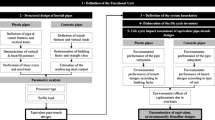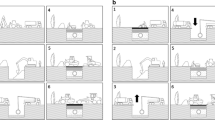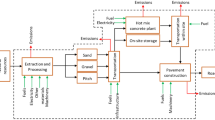Abstract
In a world with an increasing urban population, analysing the construction impacts of sanitation infrastructures through Life Cycle Assessment (LCA) is necessary for defining the best environmental management strategies. In this study, the environmental impacts of one linear meter of sewer constructive solution were analysed for different pipe materials and diameters used in Southern Europe; a unit of different sewer appurtenances (pump, manhole and inspection chamber) was also considered. The impacts of the pipe materials were compared considering different lifespan periods and high-density polyethylene (HDPE) turned out to be the worst option, being polyvinyl chloride (PVC) and concrete the most favourable ones. Few data are available on the material and energy flows in the installation stage; therefore, a comparative analysis of trenches with sand and concrete bedding was conducted. The results show that the installation stage represents up to 80 % of the total life-cycle impact of the constructive solutions. Concrete pipes with half-concrete/half-sand bedding are the best option and produce 20–30 % of the impact of HDPE pipes with concrete bedding. Hence, designers should focus not only on the pipe but also on the trench model. A methodology was presented to enable the impact aggregation of the different sewer elements, and Betanzos (Spain) was selected to conduct a pilot study in small cities. In the future, studies will need to incorporate the use and maintenance stage, as it is not standard and varies according to the physical features of the cities. Finally, this study provides basic concepts for developing eco-efficiency indicators.







Similar content being viewed by others
References
AG, Geberit International (1998) Environmental comparison of domestic sewage pipes of different materials (Ökobilanz von Rohren zur Hausentwässerung). Geberit International AG, Switzerland
Anders K, Anders A (1997) Environmental assessment of sewage pipes in PVC, PE, PP and concrete (Miljøvurdering af afløbsrør i PVC, PE, PP og beton). DOR/Nordiska Plaströrgruppen, Stockholm
Arpke A, Hutzler N (2006) Domestic water use in the United States. A life-cycle approach. J Ind Ecol 10(1):169–184
Beale DJ, Marlow DR, Cook S (2013) Estimating the cost and carbon impact of a long term water main rehabilitation strategy. Water Resour Manag. doi:10.1007/s11269-013-0386-0
Bueno MS (2010) What lies underground? Trenchless technology polls Municipalities on sewer pipe usage. 2010 Pipe materials guide, Trenchless technology special supplement, 8–11 http://www.trenchlessonline.com/pdfs/2010_Pipe_Materials_Guide.pdf
CEDEX, Centre for Hydrographic Studies (2009) Technical guide on sewer networks and urban drain (Guía técnica sobre redes de saneamiento y drenaje urbano), 3ath edn. Ministerio de Fomento. Secretaría General Técnica. Centro de Publicaciones, Madrid
CLABSA, Clavegueram de Barcelona, S.A. (Personal Communication, 2013). Acer, 16, 08038 Barcelona, Spain
Cohen R, Wolff G, Cousins E, Greenfield B (2004) Energy down the drain. the hidden costs of California’s Water Supply. Natural Resources Defense Council, Pacific Institute, Auckland, California, US
CONTEC, Control Técnico del Ciclo Integral del Agua (2012) ©Aqualogy services company
Council Directive EC 2000/60/EC of 23 October 2000 on establishing a framework for Community action in the field of water policy
CPSA, Concrete Pipeline Systems Association (2010) PAS 2050- partial lifecycle assessment. Cradle-to-gate analysis for concrete pipeline. Manhole Ring and Cover Slab, Leicester
Dennison FJ, Azapagic A, Clift R, Coulbourne FS (1999) Life cycle assessment: comparing strategic options for the mains infrastructure—part I. Water Sci Technol 39(10):315–319
EA, The Environment Agency (2008) Greenhouse gas emissions of water supply and demand management options. Science Report—SC070010
Ecoinvent (2009) Swiss Centre for Life Cycle Inventories. Ecoinvent database v3.0. Technical report. http://www.ecoinvent.ch/Accessed January 2013
EN 15804 (2011) Sustainability of construction works—environmental product declarations—core rules for the product category of construction works. European Standard. European Committee for Standardization, Brussels, Belgium
Friedrich E, Pillay S, Buckley CA (2009) Carbon footprint analysis for increasing water supply and sanitation in South Africa: a case study. J Clean Prod 17(1):1–12
GISAgua (2012) ©Aqualogy Services Company
Gleick PH (1996) Basic water requirements for human activities: meeting basic needs. Water Int 21:83–92
Griffiths-Sattenspiel B, Wilson W (2009). The carbon footprint of water. A River Network Report, Portland
Guinée JB, (ed), Gorrée M, Heijungs R, Huppes G, Kleijn R, de Koning A, van Oers L, Wegener Sleeswijk A, Suh S, Udo de Haes HA, de Bruijn H, van Duin R, Huijbregts MAJ, Lindeijer E, Roorda AAH, Weidema BP (2001) Life cycle assessment: an operational guide to the ISO standards. Parts 1 and 2. Ministry of Housing, Spatial Planning and Environment (VROM) and Centre of Environmental Science (CML), Den Haag (Guinée JB, final editor)
INTRON (1995) Environmental profile and environmental measures of a concrete external sewer [Intron report No. 95027] and Environmental profile and environmental measures of an external sewer of PVC and vitrified clay in comparison to concrete [Intron report No. 95195] (Ökobilanz für Rohre aus Beton, Ton, PVC). INTRON, Netherlands
ISO (International Organization for Standardization) (2006) Environmental management—life cycle assessment—principles and framework. International Standard 14040, Geneva
Klein G, Krebs M, Hall V, O’Brien T, Blevins BB (2005). California’s Water-Energy relationship. Final Staff Report. California Energy Commission
Knoeri C, Sanyé-Mengual E, Althaus H (2013) Comparative LCA of recycled and conventional concrete for structural applications. Int J Life Cycle Assess (online). doi:10.1007/s11367-012-0544-2
Lassaux S, Renzoni R, Germain A (2007) Life cycle assessment of water from the pumping station to the wastewater treatment plant. Int J Life Cycle Assess 12(2):118–126
Lundström H, Ölund G, Rydberg GT (1996) Life cycle assessment of a concrete sewage pipe. CIT ekologik, The Nordic project on Sustainable Concrete Technology. Chalmers Industriteknik
Mendoza JMF, Oliver-Solà J, Gabarrell X, Rieradevall J, Josa A (2012) Planning strategies for promoting environmentally suitable pedestrian pavements in cities. Transp Res Part D: Transp Environ 17(6):442–450
MetaBase ITeC (2010) Online ITeC database: prices, technical details, companies, certificates, product pictures and environmental data. http://www.itec.cat/metabase. Accessed February 2013
Nielsen CB, Schaumann J, Hvorslev S, Sejersen P (1998) Sewage pipe components in PVC, PP, HDPE and concrete (Afløbskomponenter af PVC, PP, HDPE og beton). Danish EPA, Denmark
Pearson LJ, Coggan A, Proctor W, Smith TF (2010) A sustainable decision support framework for urban water management. Water Resour Manag 24:363–376
PRé Consultants (2010) SimaPro 7.2.0. PRé Consultants, Amersfoort
Roux P, Mur I, Risch E, Boutin C (2011) Urban planning of sewer infrastructure: Impact of population density and land topography on environmental performances of wastewater treatment systems. In: Presented at the Life Cycle Conference 2011, “Policy: LCM in Public Policy” Session, Berlin
Short MD, Peirson WL, Peters GM, Cox RJ (2012) Managing adaptation of urban water systems in a changing climate. Water Resour Manag 26:1953–1981
Strutt J, Wilson S, Shorney-Darby H, Shaw A, Byers A (2008) Assessing the carbon footprint of water production. Am Water Works Assoc J 100(6):80–91
The World Bank (2012) Urban population (% of total). http://data.worldbank.org/indicator/SP.URB.TOTL.IN.ZS. Accessed March 2013
Valderrama C, Granados R, Cortina JL, Gasol CM, Guillem M, Josa A (2012) Implementation of best available techniques in cement manufacturing: a life-cycle assessment study. J Clean Prod 25:60–67
Valderrama C, Granados R, Cortina JL, Gasol CM, Josa A (2013) Comparative LCA of sewage sludge valorisation as both fuel and raw material substitute in clinker production. J Clean Prod 51:205–213
Van Drunen M, Tukker A, Rioolbuizen M (2000). Life cycle of wastewater pipes made from PVC, concrete and HD-PE. Pub: Institute for Environmental Studies (IVM) and TNO-STB, DELFT, Netherlands
Van Leeuwen CJ, Frijns J, van Wezel A, van de Ven FHM (2012) City blueprints: 24 indicators to assess the sustainability of the urban water cycle. Water Resour Manag 26:2177–2197
Venkatesh G, Brattebø H (2011) Energy consumption, costs and environmental impacts for urban water cycle services: case study of Oslo (Norway). Energy 36(2):792–800
Venkatesh G, Hammervold J, Brattebø H (2009) Combined MFA-LCA for analysis of wastewater pipeline networks. J Ind Ecol 13(4):532–550
Viñolas B (2011) Applications and methodology advances in MIVES multicriteria valorations (Aplicaciones y avances de la metodología MIVES en valoraciones multicriterio). Doctoral Thesis. Universitat Politècnica de Catalunya
Acknowledgments
This study was carried out in the framework of the AQUAENVEC project (LIFE10/ENV/ES/000520) “Assessment and improvement of the urban water cycle eco-efficiency using LCA and LCC”. The authors would like to thank the Water Technology Centre (CETaqua) and CLABSA for supplying all of the data and for their technical advice. The authors are also grateful for the support of the Spanish Ministry of Education and Science through the projects BIA2010-20789-C04-01 and CTM2010-17365.
Author information
Authors and Affiliations
Corresponding author
Additional information
Highlights
Different pipe materials and diameters were compared using LCA.
A sensitivity analysis for trenches with concrete and sand beddings was conducted.
Plastic pipes have the greatest impact due to their composition and durability.
The installation stage accounts for 80 % of the impacts in most designs.
The methodology helps to aggregate the sewer elements in any city configuration.
Electronic supplementary material
Below is the link to the electronic supplementary material.
ESM 1
(PDF 192 kb)
Rights and permissions
About this article
Cite this article
Petit-Boix, A., Sanjuan-Delmás, D., Gasol, C.M. et al. Environmental Assessment of Sewer Construction in Small to Medium Sized Cities Using Life Cycle Assessment. Water Resour Manage 28, 979–997 (2014). https://doi.org/10.1007/s11269-014-0528-z
Received:
Accepted:
Published:
Issue Date:
DOI: https://doi.org/10.1007/s11269-014-0528-z




